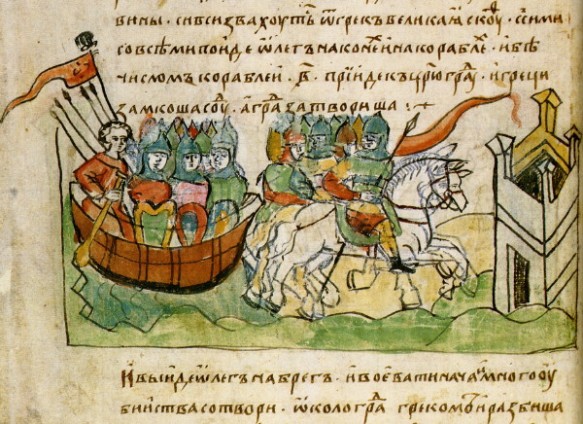Novgorod First Chronicle
Various narrative sources in Russian provide significant information concerning the wars fought by the Russians against the crusaders in the eastern Baltic region.
The most important Russian source is the Novgorodskaya pervaya letopis’ (First Novgorod Chronicle). It exists in two versions, which survive in five different manuscripts. The Older Version (Starshyi izvod) is contained in the Sinodal’nyi manuscript (MS Moscow, State Historical Museum, 786). This manuscript covers events from 1016 up to 1352, but 128 folios at the beginning and several in the middle of the manuscript (dealing with events of the years 1273–1298) have been lost. The full text of the chronicle (beginning with the year 854) can be reconstructed from the Younger Version (Mladshyi izvod), which survives in four manuscripts, the oldest of which is the Comissionnyi manuscript in the collection of the Archeographical Commission (Institute of History, St Petersburg, no. 240), dating from the mid-fifteenth century. The compilation of the text of the Sinodal’nyi version dealing with events up to 1234 was begun in the second part of the thirteenth century and completed in the middle of the fourteenth century.
The chronicle tells of the attempts of the Novgorodians to preserve their political authority in Livonia against the crusaders. The accounts of the Russian campaigns against Livonia in 1212, 1214, 1217, 1218, 1222, and 1223 correspond with the testimony in the chronicle of Henry of Livonia about Russian raids in 1210, 1212, 1216–1217, 1218, 1221, and 1223. In the opinion of Russian scholars, where the dates differ, those given by Henry are to be preferred. The siege and capture of the fortress of Dorpat (mod. Tartu, Estonia) in 1224 are mentioned in passing in the First Novgorod Chronicle. By contrast, the accounts of Russian struggles against the Livonian attempts to annex parts of the Novgorodian state in the period between the 1230s and 1260s are more informative and important for the history of the Baltic Crusades. Some of the events described are also known from the Livonian sources: the occupation of Pskov (1240–1242), the crusades into the lands of the Finnic peoples of the Novgorodian state (1241), the battle on the ice of Lake Peipus (1242), the siege of Dorpat (1262), the battle of Wesenberg (1268), and the failed attempt to capture Pskov (1269). The chronicle also contains much exclusive information. This includes the military actions of the vassals of the bishop of Dorpat together with the Russian prince Yaroslav Vladimirovich in the 1230s, the attack of the Russian and Karelian hosts against Dorpat (1253), the invasion by Livonian and Swedish troops of the lower reaches of the river Narva (1256) and the response to it by the Russians and Karelians (1256/1257), the peace treaty between Russians and the Livonians in 1270, and the defense of Pskov against the Livonians (1299 and 1323). The Comissionnyi manuscript also relates that in 1294 the Novgorodians expelled the North Estonian vassals of the Danish Crown who had started to build a fortress on the eastern bank of the river Narva; a folio that may have contained this evidence has been lost from the Sinodal’nyi manuscript. Both versions also contain much evidence about the wars between the Russians and the Teutonic Order in Livonia in the frontier region (from the 1280s onward), as well as the invasions of the order and the Swedes into the areas of the river Neva, Lake Ladoga, and Karelia.
Important original information is contained in the Zhitie Alexandra Nevskogo (Life of Alexander Nevskii), a hagiographical life of Alexander Yaroslavich, prince of Novgorod. It survives in more than 500 manuscripts (written between the end of the fourteenth and the end of the eighteenth centuries), which comprise fifteen versions. Opinions as to the time and place of its composition vary between the late 1260s and early 1280s. The Life may have been written by a monk of the monastery of the Nativity of Our Lady in Vladimir. The author drew on the annals of Novgorod and Vladimir, as well as on information recorded by someone who belonged to the entourage of Alexander Yaroslavich between the late 1230s and the prince’s death in 1263. The Life contains exclusive information about the visit of the legation of the Teutonic Order led by Andreas von Felben to Novgorod and the theological disputation between Prince Alexander and the envoys of the pope. Information about the battle at the river Neva (1240) is given in greater detail than in the First Novgorod Chronicle and forms the main part of the Life.
Events in the Life are ordered correctly, but in keeping with the genre of the text are not dated. In the fifteenth century, the text of the Life was included in the Younger version of the First Novgorod Chronicle. The information in this chronicle was in turn used in later chronicles of Novgorod, Pskov, and North-eastern Russia. The Life of Alexander Nevskii also formed part of the fourteenth-century collection known as the Slovo o pogibeli Zemli Russkoi (Account concerning the Loss of the Russian Land). Some information about the wars between the Livonians and Pskovians (from the 1280s to the end of the fifteenth century) is found in the First, Second and Third Chronicles of Pskov (fifteenth–seventeenth centuries). This information derives from the earlier annual records made in Pskov and also from the Povest’ o Dovmonte (The Story of Dovmont). The Story was written in the fourteenth century, soon after the death of Daumantas (Russ. Dovmont), the Lithuanian prince who ruled in Pskov in 1266–1299. During the years of his government, the principality of Pskov achieved its greatest independence from Novgorod, and the composition of the work was more of a political than a literary act. In writing this work the author imitated the Life of Alexander Nevskii. The text contains useful information, with particularly interesting and detailed accounts of the defense of Pskov in 1269 and 1299.
